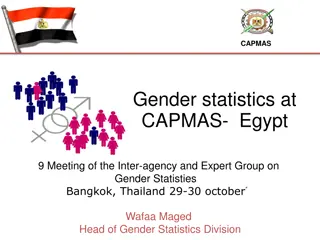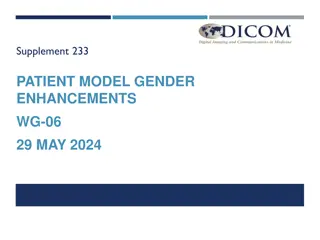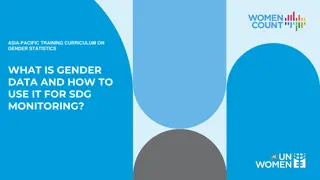Gender Statistics: Differentiating Between Sex and Gender
Explore the nuances between sex and gender in the context of statistics, uncovering the social constructs and biological differences that shape our understanding of masculinity and femininity. Delve into the importance of gender statistics, official sources, and data collection methods to ensure accurate and unbiased representation of women and men in research and policy-making.
Download Presentation

Please find below an Image/Link to download the presentation.
The content on the website is provided AS IS for your information and personal use only. It may not be sold, licensed, or shared on other websites without obtaining consent from the author.If you encounter any issues during the download, it is possible that the publisher has removed the file from their server.
You are allowed to download the files provided on this website for personal or commercial use, subject to the condition that they are used lawfully. All files are the property of their respective owners.
The content on the website is provided AS IS for your information and personal use only. It may not be sold, licensed, or shared on other websites without obtaining consent from the author.
E N D
Presentation Transcript
Introduction to Gender Statistics Session 1 Workshop Name Location and Date
Session outline 1. Difference between sex and gender 2. Overview of gender statistics 3. Skills for understanding statistics
Sex versus gender: what is the difference? Sex Male / female Biology how we are born Relatively fixed Gender Social norms Expected roles of women, men, girls and boys What it means to be masculine and feminine Can change over time
Sex or gender? Women give birth to babies, men don t (Sex) Little girls are gentle, boys are tough (Gender) Men are more capable leaders and decision-makers (Gender) Men s voices break at puberty, women s do not (Sex) Women tend to work as nurses and school teachers, men tend to work as doctors and university professors (Gender)
What are gender statistics?
Official statistics Published by government agencies or other public bodies Provide quantitative information on people s lives Economy Social development Living conditions Health, education and the environment Fundamental principles of official statistics Independence Confidentiality Professional standards
The three sources of official statistics Censuses Population and Housing Census Agriculture Census Surveys Based on a representative sample of the population More cost-effective Administrative data Bi-product of administrative processes Hospital records on number of patients, illness, etc School enrolment records
proof data data statistics Evidence Evidence- -based policy making based policy making support support verification facts facts
What are gender statistics? 1. sex-disaggregated data 2. data reflect gender issues 3. concepts and definitions accurately capture information on women and men 4. no gender bias in data collection methods
Social and demographic statistics Economic statistics Environmental statistics Gender Statistics Business statistics National accounts Tourism Transport Prices Government finance Trade and balance of payments Population Migration Labour Health Education Income and poverty Justice and crime Climate change CO2 emissions Pollution Waste management Protected areas
Gender statistics is about identifying, producing, disseminating, and analyzing statistics to understand how gender issues affect individuals and society.
Gender Statistics is not about women only, but about the role of both women and men in society.
In many countries, sex-disaggregated data and gender indicators exist but are not used. Resource Guide for Gender Theme Groups UNIFEM / UNDP / UNFPA / UNICEF / UN
National Statistical System Enrolment rates Survival rates Ministry of Education Diseases Causes of death Ministry of Internal Affairs Ministry of Health Population and housing census Agricultural census Household surveys Economic statistics Migration Tourism arrivals Taxation records Customs and Revenue Statistics Office Ministry of Environment Natural disasters People displaced Economic costs Public service employment Senior government officials Public Service Commission Ministry of Labour Ministry of Justice
National Statistical System Enrolment rates Survival rates Ministry of Education Diseases Causes of death Ministry of Internal Affairs Ministry of Health Population and housing census Agricultural census Household surveys Economic statistics Migration Tourism arrivals Taxation records Customs and Revenue Statistics Office Ministry of Environment Natural disasters People displaced Economic costs Public service employment Senior government officials Public Service Commission Ministry of Labour Ministry of Justice
ECLAC ITU UNCTAD UNDP Committee for the Coordination of Statistical Activities (CCSA) Organisation for Economic Co-operation and Development ILO UNFPA UNESCO UN Habitat UNIDO WHO World Bank FAO UNICEF United Nations Statistical Commission meets annually in New York Latin America and Caribbean Western Asia Europe Africa Asia-Pacific Conference of European Statisticians UNECE Secretariat Gender statistics Core set of gender indicators Guidelines, manuals and training materials Technical assistance Global and regional reviews Standards, methods, classifications Financial support Sharing experiences Databases and gender analysis
Summary Sex and gender are different concepts Official statistics are those published by government and international agencies Statistics provide impartial evidence Gender statistics cuts across all fields of traditional statistics to provide accurate information on women and men, boys and girls The entire statistical system is involved in producing gender statistics The international statistical system provides support and guidance























